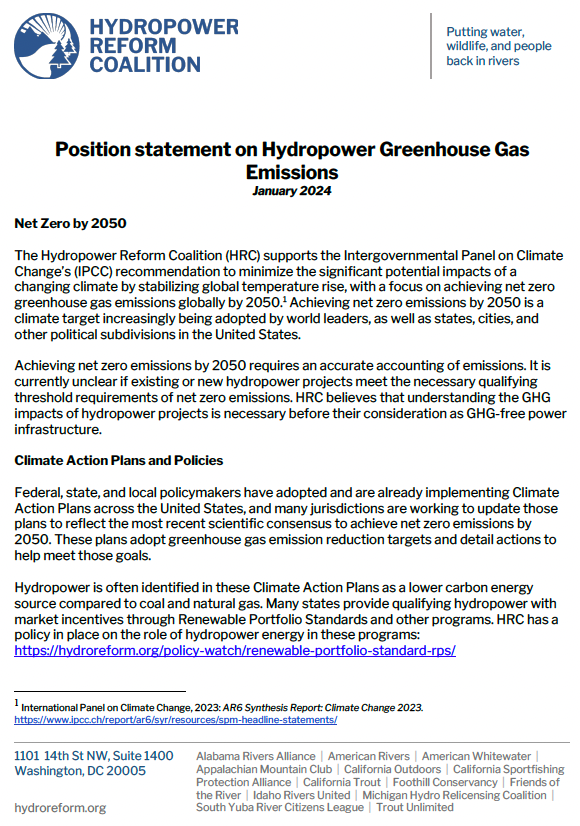Net Zero by 2050
The Hydropower Reform Coalition (HRC) supports the Intergovernmental Panel on Climate Change’s (IPCC) recommendation to minimize the significant potential impacts of a changing climate by stabilizing global temperature rise, with a focus on achieving net zero greenhouse gas emissions globally by 2050.[1] Achieving net zero emissions by 2050 is a climate target increasingly being adopted by world leaders, as well as states, cities, and other political subdivisions in the United States.
Achieving net zero emissions by 2050 requires an accurate accounting of emissions. It is currently unclear if existing or new hydropower projects meet the necessary qualifying threshold requirements of net zero emissions. HRC believes that understanding the GHG impacts of hydropower projects is necessary before their consideration as GHG-free power infrastructure.
Climate Action Plans and Policies
Federal, state, and local policymakers have adopted and are already implementing Climate Action Plans across the United States, and many jurisdictions are working to update those plans to reflect the most recent scientific consensus to achieve net zero emissions by 2050. These plans adopt greenhouse gas emission reduction targets and detail actions to help meet those goals.
Hydropower is often identified in these Climate Action Plans as a lower carbon energy source compared to coal and natural gas. Many states provide qualifying hydropower with market incentives through Renewable Portfolio Standards and other programs. HRC has a policy in place on the role of hydropower energy in these programs: https://hydroreform.org/policy-watch/renewable-portfolio-standard-rps/
Emissions Accounting for Hydropower
It is increasingly understood by scientists and policymakers that there are considerable greenhouse gas emissions related to hydropower project construction, river inundation, and the ongoing operations of these projects. These greenhouse gas emissions can vary widely depending on many factors. The IPCC has established a median greenhouse gas emission intensity for hydropower of 24 gCO₂-eq/kWh – which equates to the grams of carbon dioxide equivalent per kilowatt-hour of electricity generated allocated over its life cycle.[2] Hydropower project-specific greenhouse gas emissions can also be evaluated by increasingly sophistical modeling tools, such as the GHG Reservoir (G-res) Tool,[3] developed in partnership by the International Hydropower Association (IHA) and the UNESCO Chair in Global Environmental Change or the All-Res Greenhouse Gas Tool[4] developed by Tell The Dam Truth with support from Patagonia and Save the Colorado.
The United States Environmental Protection Agency (EPA) publishes a greenhouse gas inventory annually to track trends in U.S. emissions. In 2022, this inventory and the annual report to the IPCC included reservoir emissions, including those from hydropower, for the first time. At the same time, EPA does not include reservoirs in the Greenhouse Gas Reporting Program, and data on individual powered and non-powered reservoirs are limited.
HRC opposes the construction of new dams, diversions, and reservoirs due to the negative impacts on rivers, aquatic life, recreational opportunities, public safety, and communities. The construction of new projects and the inundation of riverine ecosystems is the largest potential source of carbon pollution within a project’s lifecycle. These impacts can be entirely avoided if new project development does not occur. However, emissions depend on many factors and are not limited to the initial construction and inundation-caused carbon release. The lasting effects of river impoundment include sedimentation, warmer water temperatures, altered watershed characteristics, and other factors that can create the conditions for methane production in some places in river systems that would not otherwise produce methane.
HRC supports the full and accurate accounting of the hydropower industry’s emissions. Accounting for emissions is critically important to ensure that policymakers are well informed of an industry’s climate impact in assessing strategies and setting programmatic policies and performance metrics to achieve net zero by 2050. Programs designed or proposed to reduce greenhouse gas emissions to achieve net zero emissions by 2050 require accurate accounting of emissions within both their reporting and eligibility components, and it is currently unclear if hydropower projects are meeting these qualifying threshold requirements.
Policy Arenas and Outcomes
HRC seeks to:
- Support additional research into greenhouse gas emissions at reservoirs and hydropower generation facilities, including methodologies for quantifying emissions and opportunities for mitigation of emissions through improved reservoir operations.
- Ensure that federal, state, and local agencies are properly accounting for the greenhouse gas emissions of hydropower operations as part of their climate goals.
- Encourage the Environmental Protection Agency to add reservoirs, including hydropower projects and their operations, to the Greenhouse Gas Reporting Program.
- Oppose and prevent the construction of new dams, diversions, and reservoirs, not just for their impacts on rivers, but also as the potential largest source of new greenhouse gas emissions from the hydropower sector that can be avoided entirely.
- Ensure that Climate Action Plans and related programs that provide incentives for a transition to net zero emissions by 2050 accurately reflect the greenhouse gas emissions from hydropower projects and their impacts on rivers.
- Inform the FERC hydropower licensing process by requiring that National Environmental Policy Act project reviews include a greenhouse gas emissions analysis for each project. For pumped storage projects, this analysis should be expanded to include the source of energy used for pumping.
- Encourage FERC to consider project emissions in their decision-making during the licensing process for existing dams, new dams, and projects that retrofit unpowered dams with hydropower.
- Address greenhouse gas impacts in a cumulative, life cycle and watershed-wide planning approach whenever possible.
- Influence federal and state regulators to promulgate rules that regulate hydropower project emissions.
[1] International Panel on Climate Change, 2023: AR6 Synthesis Report: Climate Change 2023. https://www.ipcc.ch/report/ar6/syr/resources/spm-headline-statements/
[2] Schlömer S., T. Bruckner, L. Fulton, E. Hertwich, A. McKinnon, D. Perczyk, J. Roy, R. Schaeffer, R. Sims, P. Smith, and R. Wiser, 2014: Annex III: Technology-specific cost and performance parameters. In: Climate Change 2014: Mitigation of Climate Change. Contribution of Working Group III to the Fifth Assessment Report of the Intergovernmental Panel on Climate Change. Cambridge University Press, Cambridge, United Kingdom and New York, NY, USA. https://archive.ipcc.ch/pdf/assessment-report/ar5/wg3/ipcc_wg3_ar5_annex-iii.pdf
[3] https://g-res.hydropower.org/
[4] https://tellthedamtruth.com/all-reservoir-greenhouse-gas-model/


 HRC or member-contributed
HRC or member-contributed